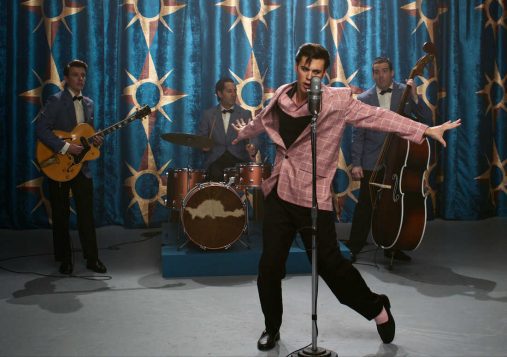Reviewed by Jeffrey Sanzel
In 1989, Raw published Richard McGuire’s six-page comic strip, Here. The thirty-five panels followed a single location but spanned 500,957,406,073 B.C. to 2033 A.D. Often, the panels contained other images within, depicting multiple time frames simultaneously. In 2014, Pantheon Books published McGuire’s full-length graphic novel. The 304 pages traced the same space from 3,000,500,000 B.C. to A.D. 22,175, concentrating on the twentieth and twenty-first centuries, predominantly focusing on the living room of a house built in 1907.
As a senior thesis project in 1991, students from Rochester Institute of Technology’s Department of Film and Video created a six-minute film of the original comic. An immersive V.R. film based on the full-length novel was designed and produced by British Fifty Nine Productions, under the direction of Lysander Ashton, with music by Anna Meredith.
Now, director Robert Zemeckis brings his adaptation to the big screen. The prolific Zemeckis broke out with the 1978 I Wanna Hold Your Hand. His work includes Romancing the Stone, the Back to the Future trilogy, Who Framed Roger Rabbit, Death Becomes Her, and Contact, among others. His 1994 Forest Gump won six Academy Awards, including Best Picture, Best Director, and Best Actor (for Tom Hanks). Over the years, Zemeckis has teamed with Hanks on Pinocchio, The Polar Express, and Cast Away. Here reunites Hanks with his Gump co-star, Robin Wright.
Zemeckis (who co-wrote the screenplay with Eric Roth) uses the basic idea and framework of the novel but instead chooses to highlight on the twentieth-century Young family that occupies the house. While still weaving back and forth through time, it eventually settles into a more chronological telling of the one family.
The first eight minutes progress through thousands of years of history (dinosaurs, volcanic eruption or asteroids, Ice Age), but then Here slows down to offer a handful of earlier years, including a native American couple and their tribe, as well as a view of the house across the street where Benjamin Franklin’s son, the loyalist William, lived. Of the former, the indigenous people seem cast from a 1960s history museum diorama. The late eighteenth-century Revolutionary War moments feel like a community theatre production of 1776.
The earliest inhabitants of the house, the Harters (Michelle Dockery and Gwilym Lee), serve little function except establishing occupancy and a nod to the Influenza Epidemic of 1918 (with a parallel later with the COVID pandemic). A slight subplot about aviation grates. The Beekmans follow—Stella (Ophelia Lovibond) and her inventor husband, Leo (David Fynn), who provide a humorous and interesting diversion.
Zemeckis trades the book’s panoramic and epic nature to emphasize the Young family’s day-to-day struggles. Recently discharged from the service, World War II veteran Al Young (Paul Bettany) purchases the house for his wife, Rose (Kelly Reilly). Here, they raise their family—two boys and a girl. The oldest, Richard (Hanks), impregnates his girlfriend Margaret (Wright) on the living room sofa. The couple weds, taking up residence in the house. What follows is years of joys and sorrows, trials and tribulations—marriage and children, illness and death.
Throughout their story, flashes of the earlier inhabitants recur, as well as the Harris family (Nikki Amuka-Bird and Nicholas Pinnock), who take the house when Richard sells it. Perhaps Zemeckis is trying to draw parallels between these disparate worlds—but, unlike McGuire—he does not succeed.
Here veers towards the saccharine when it is trying to be its most sincere. The Hallmark (card, not network) feel hovers around most of the stiff dialogue. Instead of simple, the exchanges feel simplistic. The messages about love, family, dreams, art, and loss seem predictable and lack anything bordering on revelatory. The best-landing moments can be attributed to the Young quartet and the inherent honesty in their performances, even when saddled with two- and even one-dimensional material.
From a visual standpoint, Here is almost a one-camera set-up. We view the living room straight on as it evolves and shifts, often picture-in-picture(-in picture). The effect alternates between clever and precious. Sometimes, the entire experience feels like Disney’s Carousel of Time. And speaking of Disney, the A.I. intelligence Metaphysic Life, used for face-swapping and de-aging the actors in real-time (instead of post-production), presents a young Tom Hanks looking more like the puppet Pinocchio than his real boy counterpart.
In the end, the film works and doesn’t work. For some audiences, they will embrace a concept taken to its fullest and a sometimes touching family saga. For others, Here is a gimmick with a center that is human, but not inspiring, tapping into soap opera plots that overstay the hundred-minute running time. Gertrude Stein said of her hometown, Oakland, “There is no there there.” Ultimately, with Zemeckis’s film, there is no Here there either.
Rated PG-13, the film is now playing in local theaters.

























